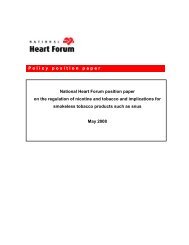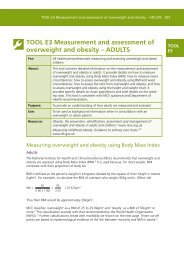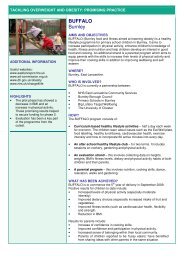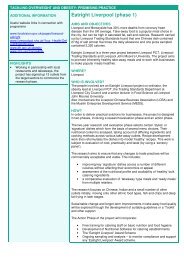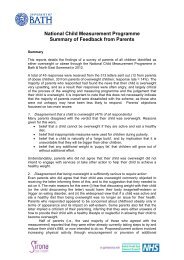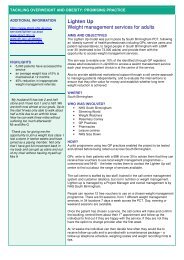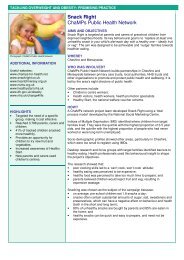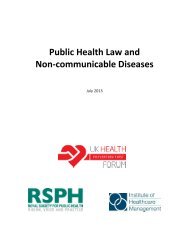The Challenge of Non-Communicable Diseases and Road Traffic ...
The Challenge of Non-Communicable Diseases and Road Traffic ...
The Challenge of Non-Communicable Diseases and Road Traffic ...
You also want an ePaper? Increase the reach of your titles
YUMPU automatically turns print PDFs into web optimized ePapers that Google loves.
8 <strong>The</strong> <strong>Challenge</strong> <strong>of</strong> <strong>Non</strong>-communicable <strong>Diseases</strong> <strong>and</strong> <strong>Road</strong> <strong>Traffic</strong> Injuries in Sub-Saharan Africa<br />
Both NCDs <strong>and</strong> RTIs are receiving global attention.<br />
<strong>The</strong> United Nations (UN) High-level meeting<br />
on NCD Prevention <strong>and</strong> Control in September 2011<br />
was only the second time that disease has been highlighted<br />
in this way, the first being AIDS a decade<br />
earlier [8]. <strong>The</strong> year 2011 also marked the beginning<br />
<strong>of</strong> the UN Decade <strong>of</strong> Action for <strong>Road</strong> Safety 2011-<br />
2020 [4]. At the World Health Assembly in May<br />
2012, Member States agreed to adopt a global target<br />
<strong>of</strong> “25 by 25” – for a 25 percent reduction in premature<br />
mortality 2 from NCDs by 2025 [9]. <strong>The</strong>y also<br />
placed a new Global Action Plan <strong>and</strong> Monitoring<br />
Framework for NCDs under consideration [10-11].<br />
NCDs <strong>and</strong> RTIs are largely preventable causes <strong>of</strong><br />
premature mortality <strong>and</strong> morbidity <strong>and</strong> a package<br />
<strong>of</strong> cost-effective measures has been identified [12-<br />
13]. It has been estimated that implementing a core<br />
package <strong>of</strong> ‘best buys’ for NCDs would cost less than<br />
US$1 per day in low-income countries, <strong>and</strong> less than<br />
US$3 per day in middle-income countries – with<br />
three dollars expected in return for every dollar invested<br />
in NCDs [14]. Achieving a 50 percent reduction<br />
in RTI fatalities in Africa by 2020 would save an<br />
estimated one million lives <strong>and</strong> 10 million serious<br />
injuries, with an estimated social benefit <strong>of</strong> around<br />
US$340 billion [15].<br />
NCDs <strong>and</strong> RTIs are a hidden yet growing health<br />
challenge for Africa. <strong>The</strong> report aims for a broader<br />
underst<strong>and</strong>ing <strong>of</strong> NCDs <strong>and</strong> RTIs within Africa’s<br />
health <strong>and</strong> development context, <strong>and</strong> explores<br />
shared drivers <strong>and</strong> potential integrated solutions. It<br />
essentially seeks to answer four questions:<br />
(1) How is the growing burden <strong>of</strong> NCDs <strong>and</strong> RTIs<br />
changing the epidemiology <strong>of</strong> SSA?<br />
(2) What determines <strong>and</strong> drives this burden, <strong>and</strong><br />
what are the commonalities with communicable<br />
diseases?<br />
(3) What is the rationale for public intervention?<br />
(4) How could resource-constrained governments<br />
approach NCD prevention <strong>and</strong> treatment <strong>and</strong><br />
road safety in a comprehensive, effective, <strong>and</strong><br />
efficient way?<br />
2 ‘Premature mortality’ in this context refers to mortality between the<br />
ages <strong>of</strong> 30 <strong>and</strong> 70 years <strong>of</strong> age due to cardiovascular disease, cancer,<br />
diabetes or chronic respiratory disease.<br />
<strong>The</strong> challenge presents risks for an already resource-constrained<br />
situation: how to respond in a<br />
way that does not further deepen any divide between<br />
communicable <strong>and</strong> NCDs, or add new vertical programs<br />
that are potentially in competition for scarce<br />
resources, but which instead could capitalize on the<br />
commonalities among disease groups, in causation,<br />
co-morbidity, <strong>and</strong> care.<br />
Development is multi-dimensional – social, economic,<br />
environmental – <strong>and</strong> the challenges, <strong>and</strong><br />
their solutions, are interlinked [6]. To sustain <strong>and</strong><br />
increase growth in an inclusive <strong>and</strong> equitable way,<br />
Africa’s governments need to adopt long-term development<br />
strategies, increasing investments in<br />
high-quality education, health, <strong>and</strong> infrastructure.<br />
To the same end, they must find ways <strong>of</strong> addressing<br />
the threat posed by NCDs <strong>and</strong> RTIs which build on<br />
existing resources <strong>and</strong> experience <strong>and</strong> take account<br />
<strong>of</strong> the many commonalities between communicable<br />
diseases, NCDs, maternal <strong>and</strong> child health, <strong>and</strong> development.<br />
This report is not a World Bank policy paper nor<br />
is it an academic review <strong>of</strong> the literature. Instead,<br />
it seeks to stimulate new ways <strong>of</strong> thinking <strong>and</strong> approaches<br />
to health <strong>and</strong> development, specifically to<br />
tackling NCDs <strong>and</strong> RTIs, within the context <strong>of</strong> SSA.<br />
It is grounded in evidence <strong>and</strong> in practical experience,<br />
drawing upon a broad <strong>and</strong> extensive review <strong>of</strong><br />
the data <strong>and</strong> literature <strong>and</strong> benefitting from the insights<br />
<strong>and</strong> experience <strong>of</strong> policymakers, analysts, <strong>and</strong><br />
managers in the field. 3<br />
While the report is comprehensive, it is intentionally<br />
not prescriptive. It systematically considers a<br />
range <strong>of</strong> functions (prevention, treatment, care) <strong>and</strong><br />
systems that cut across disease categories to highlight<br />
what can be done. To find what has been done<br />
<strong>and</strong> works, it harvests from evidence <strong>and</strong> examples<br />
from within <strong>and</strong> beyond SSA. It deliberately stops<br />
short <strong>of</strong> advocating what countries should do in the<br />
belief that more tailored, country-led approaches<br />
need to follow that take account <strong>of</strong> individual country<br />
need, capacity, <strong>and</strong> context.<br />
<strong>The</strong> report is intended for policymakers <strong>and</strong> technical<br />
staff at the national <strong>and</strong> international level,<br />
3 See Acknowledgements section, for list <strong>of</strong> experts consulted.



